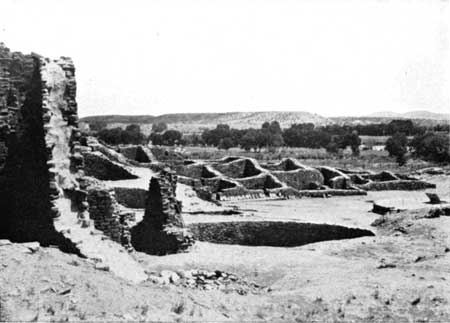![]()
MENU
|
Glimpses of Our National Monuments AZTEC RUINS NATIONAL MONUMENT |

Aztec Ruin.
Grant Photo.
The Aztec Ruins National Monument, situated near the town of Aztec, N. Mex., contains an interesting cluster of prehistoric ruins. The land included in the monument was donated to the Government in two separate tracts. The first, an area of 4.6 acres containing the remarkable Aztec Ruin, was presented to the United States by deed of gift from the American Museum of Natural History through the generosity of one of its trustees, Mr. Archer M. Huntington. By presidential proclamation dated January 24, 1923, this area was made the Aztec Ruin National Monument. Later the museum donated the land containing the remainder of the ruins, and by proclamation dated July 2, 1928, this new area, approximately 12.6 acres in extent, was added to the reservation and the name changed to Aztec Ruins National Monument. The new plot contains one major ruin about as large in ground plan as the Aztec, several smaller ruins, and a unique, well-preserved circular structure which promises to be of unusual interest.
The Aztec Ruin itself is a large E-shaped pueblo structure containing approximately 500 rooms. In ground plan and structural detail it is closely related to the great ruins of the Chaco Canyon group, and is the most striking and best preserved of the group of ruins near Aztec. The first story of the building is standing and in 24 of the rooms original ceilings are intact. The walls of many of the second-story rooms are standing and in some cases also parts of third-story rooms. The ceilings, where in place, are supported by large beams, cut and dressed with stone tools, and are interesting exhibits of work done in the Stone Age. The sandstone walls, reasonably plumb and with dressed faces, take high rank as examples of prehistoric masonry. The American Museum of Natural History conducted extensive explorations from 1916 to 1924 under the direction of Earl H. Morris, who was until 1927 custodian of the monument. This work consisted of clearing out the rooms that had been covered by débris and sand for hundreds of years, capping the standing walls to prevent further disintegration, and studying it in an effort to throw light upon its antiquity and place its builders in the aboriginal history of our country. Slightly more than half of the ruin has been completely excavated and repaired. The scientific results thus far published comprise Volume XXVI, Anthropological Papers of the American Museum of Natural History.
In one room excavated several years ago were found two levels of occupation. As revealed by the potsherds, the basal fill of refuse 3 or 4 feet in thickness was of the age of the ruins in Chaco Canyon National Monument. Overlying this deposit was a thin adobe floor and built upon this in the northwest corner was found a masonry bin roofed with mud supported by cross sticks and a reed mat. As a part of the process of rehabilitation the doors in the north and south walls had been blocked with stone, leaving a hatchway in the ceiling as the only means of access. Enough wall débris and drift sand had worked down through the hatchway to cover the secondary floor to a depth of from 3 to 6 feet. Lying immediately upon the floor were the ladder which originally stood against the western side of the hatch, a hafted axe, Mesa Verde potsherds, and a number of other objects, including the dried body of a canine, apparently a dog, which must have been confined in the room, to judge by the claw marks upon the walls.
An interesting museum collection has been installed in six of the excavated rooms. The nucleus for this museum was material loaned by the American Museum of Natural History, which conducted explorations at the monument, and several hundred specimens have been donated by local people. The manners and customs of the ancient inhabitants as deduced from their artifacts are explained to museum visitors.
The town of Aztec is on a branch of the Denver & Rio Grande Western Railroad's narrow-gage lines extending from Durango, Colo., to Farmington, N. Mex., and also on New Mexico's section of the National Park-to-Park Highway. The monument is within a mile of Aztec and easily reached.
Johnwill Faris, of Aztec, is custodian of the monument.
|
|
Last Modified: Thurs, Oct 19 2000 10:00:00 pm PDT
glimpses2/glimpses2.htm

 Top
Top